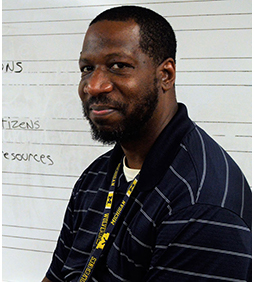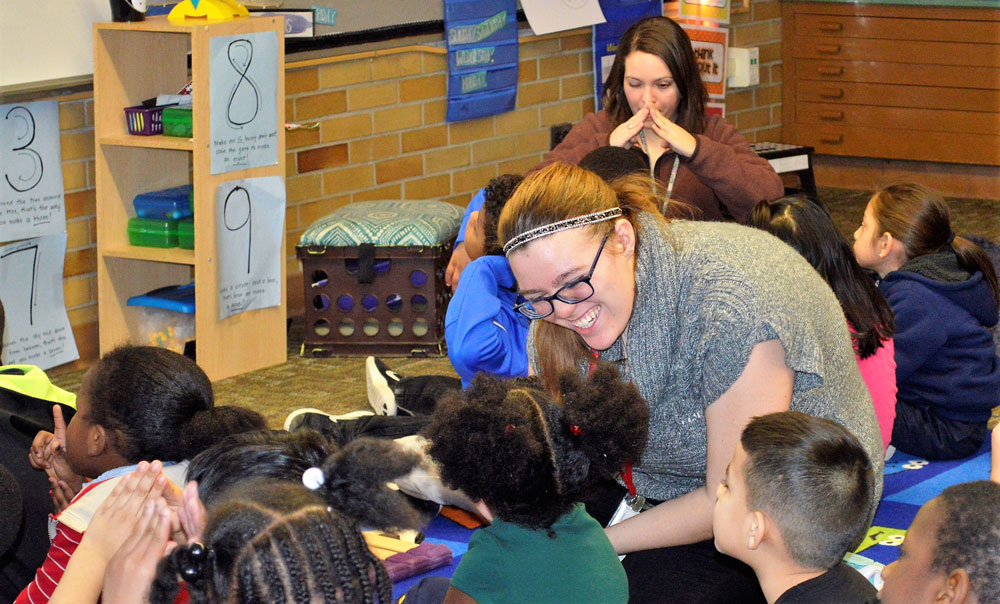Jodi Miesen rolled down her car window outside Sibley Elementary School, where she had picked up reading and math workbooks for her two children at C.A. Frost Environmental Science Academy. Speaking from a safe distance, she said the materials would supplement online learning at home for Lauren, a fourth grader, and Haley, in sixth.
“We don’t have a lot of direction right now,” Miesen said of her children’s school studies. “So we’re just kind of coming up with lesson plans on our own, and doing what we can to keep up educationally while we figure out what we’re going to do.”
A lot of parents like her have been trying to figure out what to do since Gov. Gretchen Whitmer ordered schools closed March 16. The governor announced Thursday that schools would be closed for the remainder of the school year, and provided guidance for districts to develop plans on how to provide alternatives to in-person instruction.
Related: Districts work quickly to launch distance learning plans with in-person classrooms closed
“I know this will be tough, and it will require creativity and hard work and problem-solving,” Whitmer said Thursday, praising parents for keeping kids learning at home since schools closed, and teachers for supporting their students in many ways.
Prior to Whitmer’s executive order, despite uncertainty about whether schools would reopen or whether at-home learning will count for credit, many families have been doing what they can to keep their children learning, often with help from their schools and teachers.
“I just look at it as, as long as you keep them happy and keep them learning, that’s really all you can do right now,” Miesen said. “Whether it counts or not, you know, they’re still learning. So in that sense, it still counts.
“So I’m just doing what I can to keep them busy, and not let their brains turn to mush.”
Suggested Learning Tools, Not Required
To fill the void of empty classrooms, schools have been doing what they can, too: offering online resources, suggesting daily routines, and providing paper-and-pencil activities such as the workbooks Miesen picked up — although Grand Rapids Public Schools had to discontinue those to ensure staff safety and meet social distancing requirements.
‘There’s not a day that goes by without me worrying about them.’
— Brittney DesLauries, East Leonard Elementary kindergarten teacher
Schools have been using platforms like Schoology and SeeSaw to offer remote learning opportunities – though not requiring them since not all students have equal access or the ability to work online. Whitmer’s order requires districts to provide all pupils the ability to access learning.
GRPS has developed distance-learning plans, including “the potential roll-out of technology and internet accessibility,” according to interim Superintendent Ronald Gorman. The district has invited parents to fill out a survey to assess their technology and access capabilities.

A Teacher Reaches Out
Meanwhile, teachers and principals have been connecting with students for emotional support, whether through social media like Facebook or even old-school letters sent by U.S. Postal Service and phone calls.
“They were happy to hear from me,” said Leonard “Mr. Bo” Garyson, a third grade teacher at Mulick Park Elementary, who has called all 23 of his students. “Some of them wanted to talk forever. A couple of them have called me back, just to say hi and just wanting to see what Mr. Bo is up to.”
Garyson reminds students they can still practice their academic skills if they want through online tools they’ve used in class, such as IXL and imagine learning. GRPS also offers a suite of online learning resources for all grade levels for optional academic enrichment. But nothing is assigned, only suggested.
“I know every student may not have internet access,” Garyson said. “I don’t want to leave anybody behind with something being assigned and them not being able to get to it.”
His third graders were just getting into fractions and story themes when schools closed, and Garyson worries how much they could be set back if they don’t reopen.
“We didn’t get to everything we were going to cover. They’re going to jump right into fourth grade. How much time are they going to have to review those things?”

Missing and Supporting Students
At East Leonard Elementary, kindergarten teacher Brittney DesLauries keeps in touch with her students by posting videos and photos on the classroom app SeeSaw. To those who aren’t connected she sends letters by mail, which she thought might be “a fun, new experience for them.”
“There’s not a day that goes by without me worrying about them,” DesLauries said of her 19 general education and special education youngsters. “When I start to worry I usually film a video or write a letter, just so I can tell them that they are loved and thought about.”
Bill Crane, an AP History teacher at Rockford High School, thinks about his students too – and not just the Advanced Placement tests they’ve been preparing for. Those will still happen for most subjects, Crane said, through an agreement between the College Board and colleges and universities to help students get credit. The Board is conducting online courses covering the rest of the curriculum, he said.
‘I think there’s some good that comes out of this time together, which is the sharing of time.’
— Scott Joseph, Byron Center High School principal
Though he’s been recording lectures for them to listen and respond to and linking them to TED Talks, he still misses the vital human connection.
“I, as many teachers do, thrive on the classroom environment — it feeds us and that’s now missing,” Crane said. “Online cannot and will never replace a vibrant classroom. Teachers are social beings and this is a hollow electronic experience.”
Ways for Families to Work, Play Together
Rockford Public Schools has rolled out a bundle of online learning resources, including links to counseling support for students and families. So are other districts including Northview, Lowell, Wyoming, and Forest Hills, which also offered to lend Chromebooks and other hardware to students who didn’t have them.
At Byron Center High School, its 1,150 students and their families were invited to dig into an online three-week plan of daily activities for the mind, body and soul. They include reading for 30 minutes-plus, doing SAT prep or continuing their online courses, working out, playing an instrument or writing, and talking about how the crisis is affecting each family member. A suggested schedule even includes life skills like changing the oil or setting up a budget.
In this moment of social distancing, it’s an alternative way to get at the school’s aim of helping all students learn, yet in drastically different and varied circumstances. Instead of sitting in an orderly classroom, students could be taking care of a younger sibling.
Designed to help families up until Spring Break the week of April 6, the plan is a first phase toward what Principal Scott Joseph hopes will be a course of online study throughout the spring. That will require making necessary accommodations for all students, and granting “grace and flexibility” to enable them to do well learning at home.
“We’re here to help students build success stories, that’s our mission,” Joseph said. “With this COVID-19 crisis, I want to make sure we don’t hinder their success story.”
Even though all students are issued devices, they may not all have equal access to them at home, and internet access may vary though companies are providing free Wi-Fi and hot spots, Joseph noted. And some subjects, such as math and foreign language, are “extremely difficult” to learn online, whereas a reading and essay in English translate more readily, he said.
“We want to be very careful that we are focusing on skill development, but not stressing out both students and families in an area that we know there are some things that are not made for remote learning,” Joseph said.
Following Spring Break, he says teachers are preparing online work that students can complete through the Schoology learning management system. He hopes all students will be able to take advantage of it and receive credit for their work, providing the district meets legal requirements for serving all students.
‘Whether it counts or not, they’re still learning. So in that sense, it still counts.’
– Jodi Miesen, mother of two students
For now, he hopes families are enjoying this compulsory but perhaps welcome chance to be together, studying, working and playing, as is his own family with two students.
“I think there’s some good that comes out of this time together, which is the sharing of time,” he said. “A lot of families have the ability right now to spend some quality time and do some of those things.”
Sad News for One Family
As for Jodi Miesen and her two school children, Whitmer’s announcement was difficult to process. Miesen said the kids were “pretty upset” and missing their friends.
“I’m a substitute teacher so this has affected us on so many levels,” she said. “I’m very sad for my kids. They are to continue online learning, which is the only option we have, but I mourn the loss of all our social norms.
“I feel bad for everyone, especially the seniors.”









